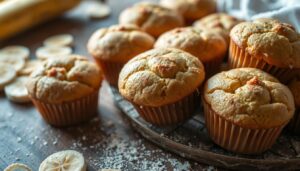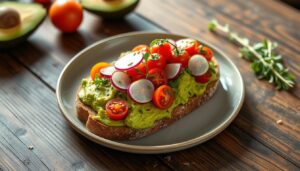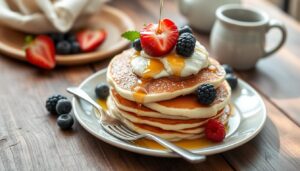Imagine a lazy Sunday morning. The kitchen fills with the scent of cinnamon and vanilla. You’re about to enjoy a slice of golden-brown French toast. Its crispy outside and fluffy inside are a treat for your taste buds.
Making perfect French toast is not hard, but it needs focus. Choosing the right bread and the perfect egg-to-milk mix are key. It’s a way to make your breakfast special, whether you love brunch or just want to start your day right.

Let’s uncover the secrets of making French toast like a pro. We’ll talk about picking the best bread and cooking it just right. Your next batch will impress everyone, blending comfort with gourmet flavors.
Table of Contents
Key Takeaways
- Use dense bread like challah for ideal texture
- Aim for a 1:¼ ratio of eggs to milk/cream
- Slice bread 1 to 1½ inches thick for fluffy centers
- Cook at 350°F-375°F for 2 minutes per side
- Experiment with toppings like berry coulis or sugar-spice coating
- Serve with butter, maple syrup, and fresh berries for a classic touch
Understanding the Basics of Perfect French Toast
French toast is a beloved breakfast classic. It’s simple yet indulgent. To make restaurant-quality french toast, you need to know its basics and techniques.
What Makes French Toast Perfect
Perfect french toast has a crispy golden outside and a soft, custardy inside. This magic happens when you cook custard-soaked bread in a hot pan. The result is a delightful contrast of textures.
The ideal slice should have a slight crunch. When you bite into it, a creamy center melts in your mouth.
The Science Behind French Toast
The transformation of bread into a tasty treat is fascinating. Soaking bread in an egg mixture starts a chemical process. The proteins in the eggs coagulate as they cook, making the bread custard-like.
The Maillard reaction, which happens when you heat amino acids and sugars, gives the toast its golden color and rich flavor. This reaction is key to the crispy french toast exterior.
Common Mistakes to Avoid
To make cinnamon-spiced toast perfect, avoid these common mistakes:
- Using fresh instead of stale bread
- Oversaturating the bread
- Cooking at too high a temperature
- Skimping on flavoring ingredients
| Ingredient | Recommended Amount | Purpose |
|---|---|---|
| Eggs | 2-4 per cup of milk | Custard base |
| Milk | 1 cup | Liquid for custard |
| Sugar | 1-2 tablespoons | Sweetness and caramelization |
| Cinnamon | 1 teaspoon | Flavor enhancer |

By understanding these basics, you’re well on your way to creating the perfect french toast. Remember, practice makes perfect. Don’t be afraid to try different bread types and flavorings to find your ideal combination.
Essential Ingredients for Classic French Toast
Creating the perfect cinnamon french toast starts with the right ingredients. A homemade french toast recipe is easy to master with the right components. Let’s explore the essentials for making classic french toast that will impress your family and friends.
Choosing the Right Bread
The foundation of any easy french toast recipe is the bread. Choose thick-sliced varieties like challah, brioche, or sourdough. These types hold up well during soaking and cooking. For the best results, use day-old bread as it absorbs the custard mixture better.

Egg and Milk Ratio
The perfect custard base requires the right egg-to-milk ratio. For every cup of milk, use 3 large eggs. This balance ensures a rich and creamy texture. You can experiment with milk alternatives like oat or almond milk for dietary preferences.
Sweeteners and Flavorings
Enhance your french toast with sweeteners like maple syrup, honey, or granulated sugar. For added depth, incorporate vanilla extract or a splash of bourbon. These elements elevate the flavor profile of your classic french toast.
Essential Spices and Extracts
Cinnamon is a must for that iconic cinnamon french toast taste. Add a pinch of nutmeg for warmth and complexity. For a gourmet twist, try almond extract or cardamom. Remember, a little goes a long way with spices, so use them sparingly.
| Ingredient | Quantity | Purpose |
|---|---|---|
| Thick-sliced bread | 6 slices | Base |
| Eggs | 6 large | Structure |
| Milk or cream | 1 1/2 cups | Moisture |
| Vanilla extract | 2 tablespoons | Flavor |
| Cinnamon | 1/2 teaspoon | Spice |
With these essential ingredients, you’re ready to create a delicious homemade french toast that rivals any brunch spot. Remember, the key to perfect french toast lies in quality ingredients and the right proportions.
The Best Bread Choices and Preparation
Choosing the right bread is key for perfect french toast. Brioche is a top pick because it’s thick and soaks up the custard well. Challah is also great, with its eggy texture and strength.
French bread, especially baguettes, has a crisp crust and thick crumb. Sourdough adds a tangy flavor. Any thick-sliced white bread is perfect for a classic taste.

- Slice it at least 3/4 inch thick
- Use bread that’s 1-2 days old
- For fresh bread, lightly toast or leave out overnight
When making your french toast batter, aim for this ratio:
| Ingredient | Amount |
|---|---|
| Whole milk | 1 cup |
| Large eggs | 4 |
| Sugar | 1 tablespoon |
| Vanilla extract | 2 teaspoons |
| Ground cinnamon | 1/2 teaspoon |
Dip each slice in the mixture for about 3 seconds per side. This makes sure you get a crispy outside and a custardy inside. It works for brioche or any other bread.
Creating the Perfect Custard Base
The heart of any great French toast is its custard base. This egg mixture is the foundation of your breakfast masterpiece. Let’s explore the key elements for a perfect French toast batter.
Optimal Egg-to-Milk Ratio
For the best custard base, aim for a 3:1 egg-to-milk ratio. This balance gives a rich flavor without being too eggy. Use whole milk or a mix of milk and cream for a luxurious texture. Try non-dairy alternatives like almond or coconut milk for something different.
| Ingredient | Amount | Purpose |
|---|---|---|
| Eggs | 3 | Structure and richness |
| Whole milk | 1 cup | Creaminess and moisture |
| Vanilla extract | 1 teaspoon | Flavor enhancer |
| Ground cinnamon | 1/4 teaspoon | Warm spice note |
Adding Sweeteners and Spices
Enhance your custard base with sweetness and spice. Add 1-2 tablespoons of sugar per cup of milk for a touch of sweetness. A pinch of salt balances the flavors. Cinnamon and nutmeg add warmth to your French toast batter.
Mixing Techniques for Smooth Batter
To get a silky-smooth egg mixture, whisk ingredients well. For extra smoothness, use an immersion blender. Some chefs add a small amount of cornstarch to thicken the custard base, making the exterior crisp.

With these tips, you’ll make a custard base that turns ordinary bread into extraordinary French toast. The secret to perfection is in the details of your egg mixture.
Mastering the Soaking Technique
The art of soaking bread is key to making great French toast. It’s all about getting the right texture. Let’s explore how to make French toast that’s not soggy.
Proper Soaking Times
Timing is crucial when soaking bread for French toast. You want to soak it for 5-10 seconds on each side. This depends on the bread’s thickness and how fresh it is.
The goal is for the bread to soak up the custard but still hold its shape. This way, you get a crispy outside and a soft inside.
Temperature Considerations
Using room temperature ingredients is important. Cold eggs and milk can make the bread soak unevenly. This can lead to French toast that’s not even in texture.
Take your ingredients out of the fridge about 30 minutes before you start. This ensures they’re at the right temperature for soaking.
Preventing Soggy Toast
To prevent soggy French toast, follow these tips:
- Use slightly stale bread, as it holds up better in the custard
- Let excess batter drip off before cooking
- Gently press the bread while soaking for even absorption
- Cook on medium to medium-high heat for 2-3 minutes per side
| Bread Type | Ideal Soaking Time | Texture Result |
|---|---|---|
| French Loaf | 8-10 seconds | Crispy exterior, soft interior |
| Brioche | 5-7 seconds | Rich, buttery texture |
| Challah | 6-8 seconds | Fluffy, slightly eggy |
Mastering these soaking techniques will help you make perfect French toast every time. Remember, the more you practice, the better you’ll get. Try different breads and soaking times to find your favorite.
Cooking Methods and Temperature Control
Mastering the art of cooking french toast requires understanding different methods and temperature control. Pan-fried french toast is a classic approach, while baked french toast offers a convenient option for larger. Let’s explore these techniques to help you achieve golden-brown perfection.
For pan-fried french toast, preheat a non-stick skillet over medium heat. Add a mixture of butter and oil for optimal flavor and to prevent sticking. Cook each slice for 2-3 minutes per side until it turns a beautiful golden brown. Maintaining consistent heat is crucial for even cooking.
Baked french toast is ideal for feeding a crowd. Preheat your oven to 350°F and assemble your french toast casserole in a baking dish. Cook for about 45 minutes, allowing the custard to set and the top to crisp up nicely.
“French toast should be creamy on the inside and crispy on the outside.”
Regardless of the method you choose, temperature control is key. Too high heat will burn the outside while leaving the inside undercooked. Too low heat will result in soggy toast. Aim for that sweet spot where the custard sets at around 160°F, creating the perfect texture.
- Use quality bread like challah or brioche for best results
- Soak bread slices in custard for optimal flavor absorption
- Cook until golden brown for a crispy exterior
Remember, practice makes perfect. Experiment with different cooking methods and temperatures to find your ideal french toast technique. Soon, you’ll be whipping up restaurant-quality french toast in your own kitchen!
Achieving the Golden-Brown Crust
The secret to crispy french toast is a golden-brown crust. It needs careful attention and the right technique. Let’s dive into how to get that perfect crunch.
Pan Selection and Heat Management
Use a heavy-bottomed non-stick pan or a well-seasoned cast iron skillet. They distribute heat evenly. Keep your stove at medium heat to prevent burning. This way, you get a crispy outside and a soft inside.
Butter vs. Oil Debate
For the best taste and texture, mix butter and oil. Butter adds richness, and oil stops burning. Together, they make a golden-brown crust that’s both tasty and crispy.
Timing and Flipping Techniques
Cook your french toast for 2-3 minutes on each side. Flip it when the bottom is golden. Don’t press down on the toast to keep it soft inside. Sprinkle sugar on the bread for extra caramelization.
| Cooking Method | Time | Temperature |
|---|---|---|
| Stovetop | 2-3 minutes per side | Medium heat |
| Griddle | 1.5-2 minutes per side | 350°F |
Creating perfect crispy french toast takes patience. Enjoy the process of making this tasty breakfast.
Classic and Creative Toppings
No French toast is complete without the perfect toppings. The classic trio of maple syrup, powdered sugar, and butter is a favorite. But why stop there? Your French toast adventure is just beginning with these delicious options.
Fruit toppings add a burst of freshness. Try ripe banana slices, fresh berries, or homemade strawberry compote. For a creamy twist, add whipped cream or vanilla ice cream. Health-conscious eaters might prefer yogurt with granola for crunch.
For those with a sweet tooth, try chocolate-hazelnut spread, peanut butter, or lemon curd. Cinnamon sugar or apple butter add a warm flavor. Want savory? Top with crispy bacon or breakfast sausages for a hearty meal.
To elevate your breakfast, host a French toast party with a topping bar. This lets guests customize their French toast with many toppings. From classic maple syrup to adventurous combinations, the possibilities are endless. The best French toast is the one that satisfies your taste buds!
F.A.Q
What’s the best type of bread for French toast?
The best bread for French toast is slightly stale, thick-sliced. Brioche, challah, or French bread work great. They’re sturdy and have a rich flavor. The bread should be at least 3/4 inch thick and preferably 1-2 days old.
How do I prevent my French toast from becoming soggy?
To avoid soggy French toast, use stale bread and let excess batter drip off. Soak bread slices for 5-10 seconds per side. The bread should absorb the custard but stay intact.
What’s the ideal egg-to-milk ratio for French toast batter?
The best egg-to-milk ratio is 3 eggs per cup of milk. This creates a custard-like texture. Using whole milk or a mix of milk and cream makes it richer.
How can I achieve a crispy exterior on my French toast?
For a crispy exterior, cook French toast on a preheated skillet or griddle. Use butter and oil for flavor and to prevent burning. Cook for 2-3 minutes per side until golden. Sprinkling sugar on the bread before cooking adds extra caramelization.
What are some classic toppings for French toast?
Classic toppings include maple syrup, powdered sugar, and butter. Fresh berries, sliced bananas, or sautéed apples are great fruits. Whipped cream, vanilla ice cream, or yogurt add creaminess.
Can I make French toast ahead of time?
Yes, you can make French toast ahead of time. For large batches, try oven-baked French toast casseroles. These can be prepared the night before and baked in the morning. Use a 350°F oven for about 45 minutes.
What flavorings can I add to my French toast batter?
Essential flavorings include vanilla extract, cinnamon, and a pinch of salt. Nutmeg or almond extract can add depth. You can also try spices like cardamom or ginger for unique flavors.
How do I know when my French toast is done cooking?
Your French toast is done when it’s golden-brown on both sides and firm to the touch. The inside should be custardy but not raw. It usually takes 2-3 minutes per side on medium heat.
Can I use fresh bread for French toast?
While stale bread is preferred, you can use fresh bread if needed. If using fresh bread, lightly toast it or leave it out overnight. This helps it absorb the custard without falling apart.
Are there any savory French toast options?
Yes, there are savory French toast options. Omit the sugar and sweet spices from the batter and add herbs or cheese. Savory toppings include bacon, breakfast sausages, avocado, or even fried chicken. Some enjoy it with savory curries or steak for a unique taste.



